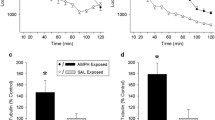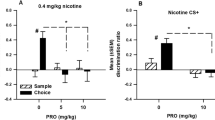Heading
Abstract
Rationale. It is not known whether dopamine agonist-induced disruption of prepulse inhibition (PPI) can be conditioned to the environment, a phenomenon established for dopamine agonist-induced locomotor activation and other behaviors. Furthermore, the literature is contradictory regarding whether PPI disruption, like locomotor activity, can become sensitized after repeated dopamine agonist administration. Differences in methodology (e.g. drug-environment pairing) may have contributed to these contradictory findings.
Objectives. In a series of studies, we investigated whether dopamine agonist-induced disruption of PPI could be conditioned and whether repeated administration of dopamine agonists, in a paradigm favorable to conditioning, would produce sensitization to dopamine agonist-induced disruption of PPI.
Methods. One group of rats were administered subcutaneous apomorphine (0.5 mg/kg) daily for 7 (experiment 1) or 5 (experiment 3) consecutive days contingent with startle testing (in testing rooms, immediately before test sessions). A second group received the same apomorphine dose daily in a manner non-contingent with behavioral testing (in home cages after test sessions). The following day, all rats received vehicle injections contingent with the test environment to assess for environmental conditioning (vehicle challenge day). The next day, all animals received a challenge of apomorphine (0.5 mg/kg) contingent with the test environment to assess the contribution of drug-environment pairing on changes observed in apomorphine-induced disruption of PPI (apmorphine challenge day). PPI was measured immediately after drug injections in the test environment. A separate study (experiment 2) tested amphetamine (3.0 mg/kg) using a similar methodology. In a fourth study, rats were pretreated with haloperidol (1.0 mg/kg) or saline prior to receiving daily apomorphine to see if haloperidol could modify the changes in PPI produced by repeated apomorphine administration.
Results. On the vehicle challenge day, PPI exhibited by the rats that received daily apomorphine contingent with the testing environment did not differ from the group that received vehicle contingent with the testing environment. However, animals receiving apomorphine contingent with testing exhibited partial tolerance to its PPI effects during the conditioning period. The PPI exhibited by both groups did not differ significantly on the apomorphine-challenge day. Amphetamine produced a complete tolerance to its PPI effects by day 3. Haloperidol pretreatment blocked the PPI tolerance produced by repeated apomorphine injections.
Conclusions. These results suggest: 1) unlike locomotion, PPI disruption induced by apomorphine cannot be conditioned to the environment; 2) unlike locomotion, repeated adminstration of dopamine agonists produce tolerance, rather than sensitization, to PPI; 3) environmental factors do not seem to be critical for PPI tolerance; and 4) dopamine receptors mediate PPI tolerance to apomorphine.
Similar content being viewed by others

Author information
Authors and Affiliations
Additional information
Electronic Publication
Rights and permissions
About this article
Cite this article
Feifel, D., Priebe, K., Johnstone-Miller, E. et al. Sensorimotor gating effects produced by repeated dopamine agonists in a paradigm favoring environmental conditioning. Psychopharmacology 162, 138–146 (2002). https://doi.org/10.1007/s00213-002-1026-1
Received:
Accepted:
Published:
Issue Date:
DOI: https://doi.org/10.1007/s00213-002-1026-1



